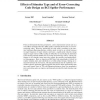Free Online Productivity Tools
i2Speak
i2Symbol
i2OCR
iTex2Img
iWeb2Print
iWeb2Shot
i2Type
iPdf2Split
iPdf2Merge
i2Bopomofo
i2Arabic
i2Style
i2Image
i2PDF
iLatex2Rtf
Sci2ools
NIPS
2008
2008
Effects of Stimulus Type and of Error-Correcting Code Design on BCI Speller Performance
From an information-theoretic perspective, a noisy transmission system such as a visual Brain-Computer Interface (BCI) speller could benefit from the use of errorcorrecting codes. However, optimizing the code solely according to the maximal minimum-Hamming-distance criterion tends to lead to an overall increase in target frequency of target stimuli, and hence a significantly reduced average target-to-target interval (TTI), leading to difficulties in classifying the individual event-related potentials (ERPs) due to overlap and refractory effects. Clearly any change to the stimulus setup must also respect the possible psychophysiological consequences. Here we report new EEG data from experiments in which we explore stimulus types and codebooks in a within-subject design, finding an interaction between the two factors. Our data demonstrate that the traditional, rowcolumn code has particular spatial properties that lead to better performance than one would expect from its TTIs and Hamming...
Information Technology | Maximal Minimum-Hamming-distance Criterion | NIPS 2008 | Stimulus Type | Visual Brain-computer Interface |
| Added | 29 Oct 2010 |
| Updated | 29 Oct 2010 |
| Type | Conference |
| Year | 2008 |
| Where | NIPS |
| Authors | N. Jeremy Hill, Jason Farquhar, Suzanna Martens, Felix Bießmann, Bernhard Schölkopf |
Comments (0)

